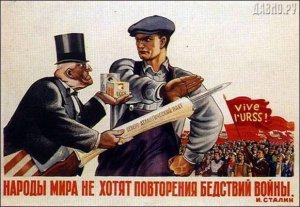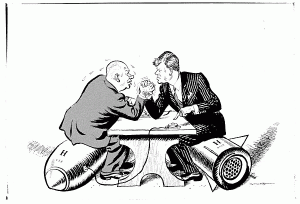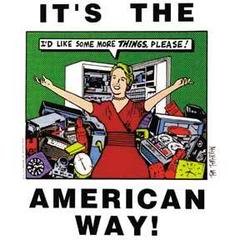We have all heard of the Red Scare, the fear of communism in the USA, but was there a “Blue Scare” (fear of capitalism) in the Soviet Union?

This poster is of a Soviet worker refusing to fall for the temptations of American Capitalism. A major fear for the Soviet Union.
McCarthyism is the practice of making accusations of disloyalty, subversion, or treason without proper regard for evidence. The term has its origins in the period in the United States known as the Red Scare. This period was characterized by heightened fears of communist influence on American institutions and spying by Soviet agents. The term is also now used more generally to describe reckless, unsubstantiated accusations, as well as attacks on the character or patriotism of political adversaries. Everyone who went into politics during this “Red Scare” would always accuse the other party of having “Communist Goals”. (Byman, 56-62)
While fear of Communism spreading in America was rampant, I often wondered if the same idea was going on in the Soviet Union at the time. Was the Soviet Union also completely afraid of Capitalism spreading throughout the country? The answer is yes, and no.
This is a very good article explaining the Purges and Hysteria that spread throughout the Soviet Union. Click on it to read, as it covers a lot of the reasons why the Soviet Union and Stalin were so paranoid.
For the Americans, a Communist was a person who could spread (certain) ideas. It was the communist ideas that were feared, because they could spread via the political system. They could be bundled into a political campaign and eventually lead to a change in the laws of the state. Thus, what the Americans feared were general political and economic changes.
In the Eastern Bloc the political and economic system was deemed solid. It was not imagined as possible for capitalist ideas to spread through politics. There was no political freedom since there was only one “leading” party. So the fear was that capitalist ideas would corrupt people individually, much like a disease would affect a single person at a time. (Edmonds, 113-120)
In the early, formative years, while “Communism” was still being established, the major fear was that the “infected” would cause damage to the still fragile “new order” within the communist state. A person with affiliation to Capitalism would become a spy, he would export state secrets or actually damage equipment, and of course spread “capitalist vices” amongst the population. (Haynes, 98-102)
In those times the general population in the East did indeed fear “capitalism”, as it was seen as a damaging force within their everyday life. For example, a factory breakdown would often be attributed to a spy damaging the equipment. Same for a crop blight, etc.
Communism had its own cultural symbols, which were clearly defined and considered unchangeable. All cultural content had to concern itself with “the working class” and its communist values. The rebelliousness of rock-and-roll and the individuality of the skintight jeans were opposing their community spirit and uniformity of life. (Haynes, 39-40)
The problem? America was now seen as a place where people had better things.
It was at that time feared that the “infected” (with capitalist ideas) would behave in a disruptive way which would affect the values of the communist society. It was not the political and economic system that was endangered, but the minds of the people, society itself.
To counter this growing affection for “western joys”, the political leaders started to emphasize on the negative issues of capitalism, such as racism, unemployment, the homeless, the street violence, and of course the nuclear threat and general warmongering. With the spread of television, such images became widely available. (Haynes, 42-45)
The fear of capitalism then was well defined and quite strong amongst the general population. It was very natural to fear losing your job, becoming homeless, being bullied because of your appearance, or being beaten by gangs or by ruthless police. And all that could happen if capitalism came to town!
Due to propaganda, “Capitalism” and “America” were the interchangeable in people’s minds. This type of fear was an automatic response to which people had been trained for decades.
Sources:
Byman, Jeremy (2004). Showdown at High Noon: Witch-hunts, Critics, and the End of the Western. Scarecrow Press.
Haynes, John Earl, and Harvey Klehr (2003). In Denial: Historians, Communism, and Espionage. Encounter.
Edmonds, Robin. Soviet Foreign Policy: The Brezhnev Years (1983)



